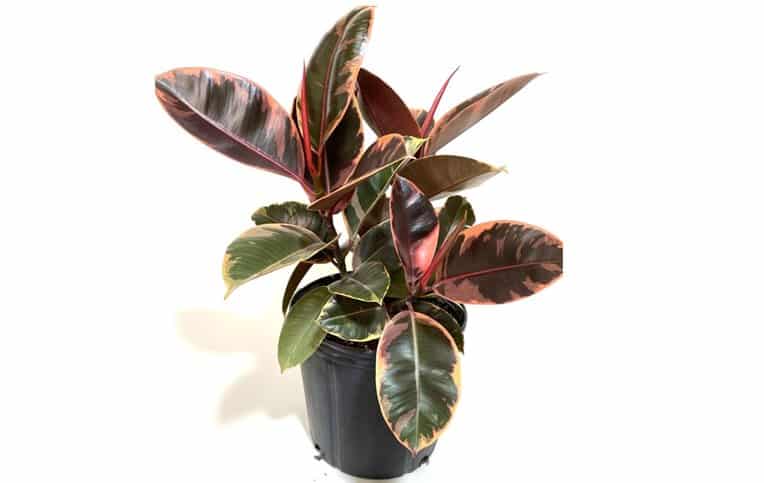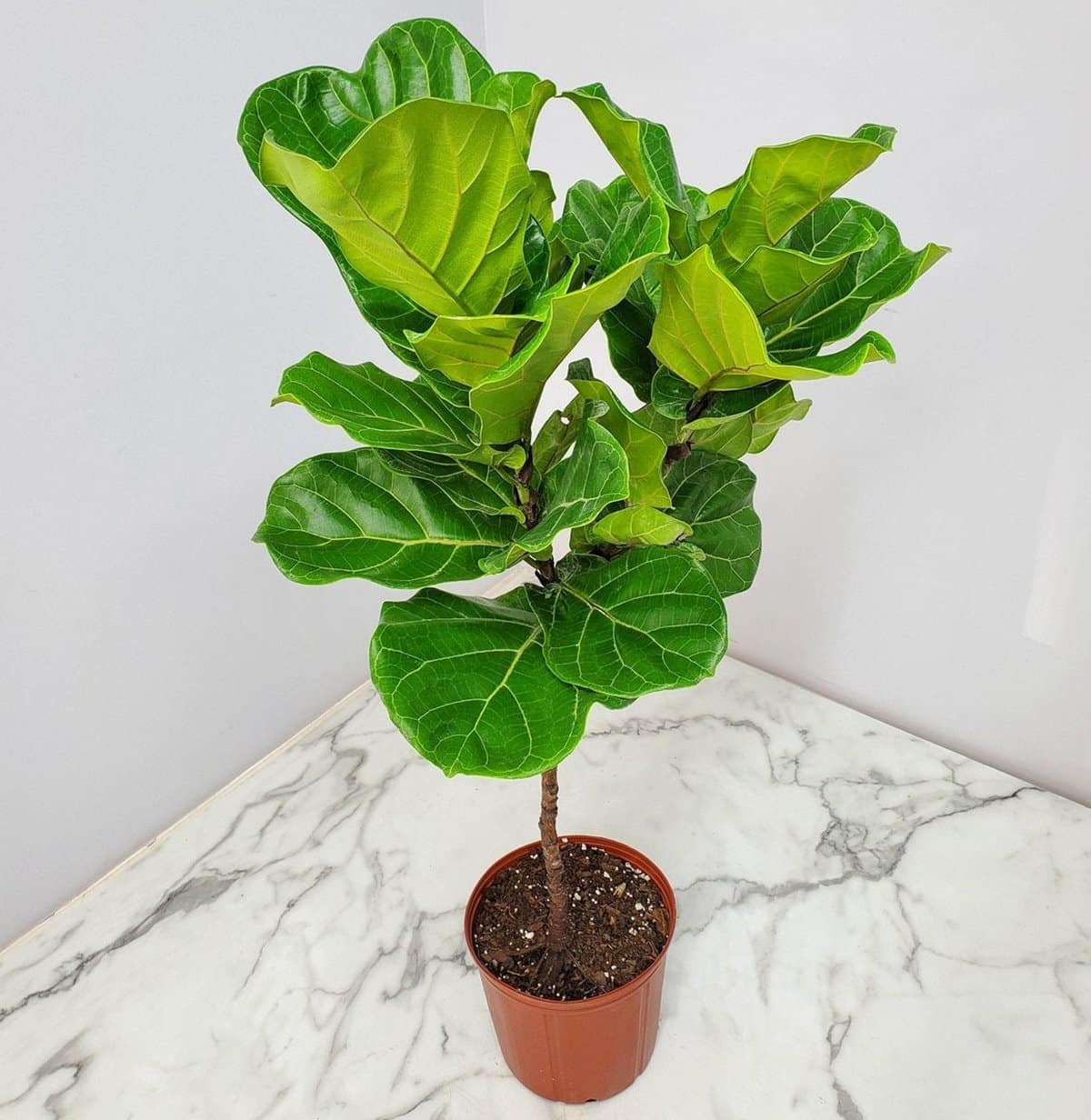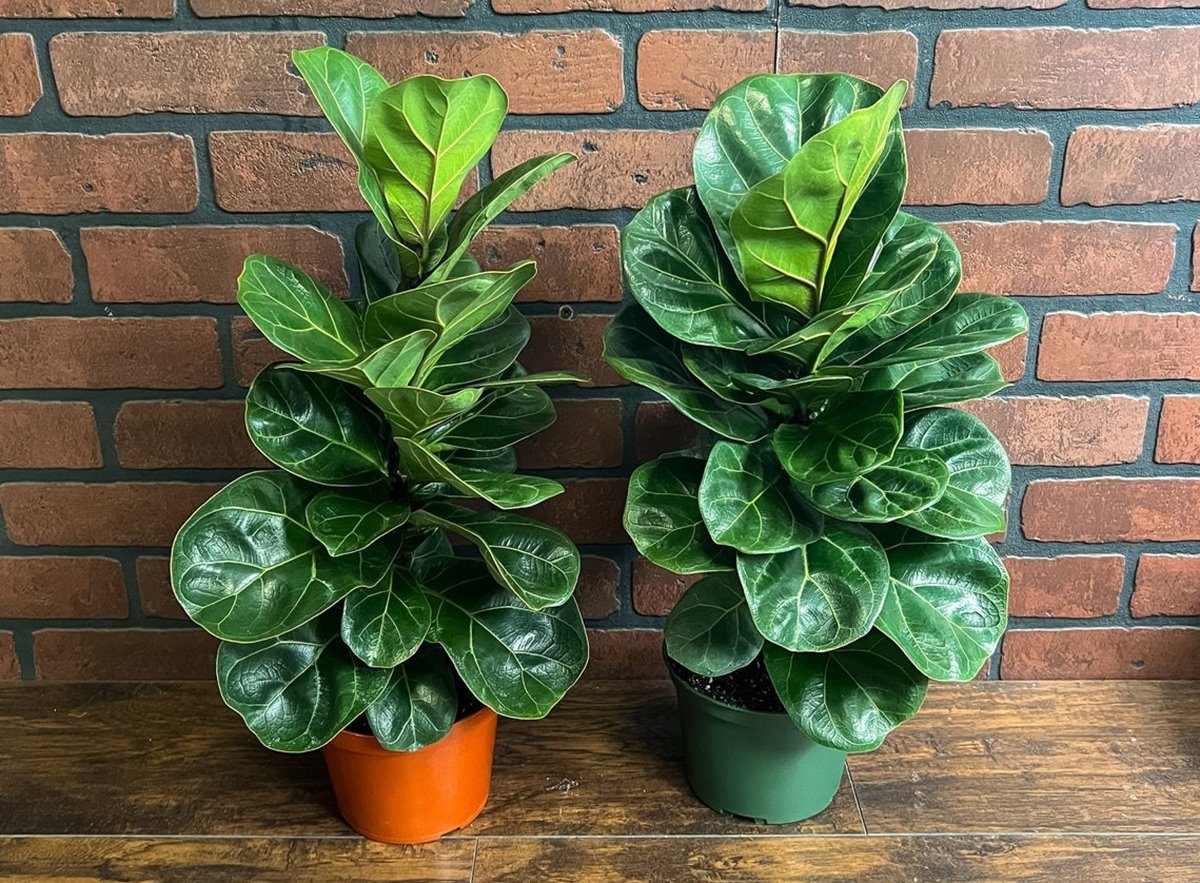Is your rubber plant leaves curling, and you don’t know why? The most likely causes are underwatering, low humidity, too much light, extreme temperatures, or shock after repotting or transplant. But it may occur due to nutritional deficiencies, pests, if your plant is rootbound, etc.
Discover all the reasons Ficus elastica (India rubber tree, India rubber plant, India rubber fig or rubber tree) curling including up or downward.
We will also give you other common signs accompanying each and what to do or how to fix the problem. These will be things like leaf yellowing or browning or your plant drooping. Also, there may be spots (yellow, brown, or black) brown tips, and edges.

Contents
- Rubber plant leaves curling reasons and fixes
- 1. Moisture issues – overwatering and underwatering
- 2. Low humidity
- 3. Extreme temperatures
- 4. Too much light
- 5. Transplant or repotting shock
- 6. Pests
- 7. Nutritional deficiency
- Less common rubber plant leaves curling causes
- Rubber plant leaves curling down
- Rubber plant leaves curling up reasons
- Rubber plant leaves drooping and curling
Rubber plant leaves curling reasons and fixes
Rubber plant leaves curling is a reaction or response to stimuli intended to minimize water loss. It occurs if the plant doesn’t get enough water or loses too much. The other reason is to protect or prevent leaf damage in case of too much light, heat, or frost.
But to a few plants, the curling and wrinkly look is typical, and it can also occur in aging leaves.
Some of the primary triggers or causes of this leaf curling include the following.
1. Moisture issues – overwatering and underwatering
Underwatering is the number one reason for rubber plant leaves curling, and the curling is a response to prevent further water loss now that it isn’t even enough. Feel if the soil is dry. Then check for leaf scorch (crispy brown tips and edges) and drooping or wilting.
More signs that your plant is thirsty include leaves falling and withering. If you don’t water it for long enough, it may die.
On the other hand, overwatering may make leaves curl or appear droopy, though not the most common reason. It happens since a wet potting mix cuts oxygen from roots. If they cannot breathe, they will not absorb water or even nutrients effectively.
Besides a wet potting mix, more signs of an overwatered rubber plant include lower leaves turning yellow (most common), brown or black splotches, a moldy potting mix, mushy stem base, etc.
What to do
Water your rubber plant when a few top inches of the potting mix feel dry, i.e., up to the first knuckle of your finger. If you have a soil moisture meter, water when the reading is in the dry zone. But never let the soil completely dry or wait until you start seeing leaves droop, curl, etc.
To know it is time to water, I usually insert my XLUX Soil Moisture Meter in the potting mix, middle way from the pot and plant. If the reading is three or less, I know it is time to give my plant a drink.
How often to water your Ficus elastica depends on your conditions (temperature, humidity, or light), plant size, potting mix, pot type, etc. So, always feel or test the soil.
If thirsty, you will need to water your plant thoroughly. Next, check if the potting mix dries too often or the pot is too small and do the necessary amendment. They may make the soil dry too fast.
On the other hand, for overwatered plants, hold the watering and ensure optimum conditions. Also, check if the soil is compact, doesn’t drain, or the drainage holes are blocked and make corrections where necessary.
2. Low humidity
Low humidity or dry air will increase moisture loss from leaves. In response, your Ficus elastica will curl its leaves inward or upward to help reduce the loss. The tell-tale signs of low humidity include leaves with crispy brown tips and edges, increased water needs, drooping and wilting, stunted growth, etc.
What to do
Rubber plants prefer medium to high humidity, 50% or more. If your home has very low humidity, mist your plant, have a pebble tray, or move it to more humid rooms if well lit. The kitchen or bathroom are such rooms.
The other way to raise humidity is by grouping plants to create a microclimate. But if you want total control, buy a humidifier.
Any good brand of cool mist humidifier will work well. I use AquaOasis™ Cool Mist Humidifier for our medium room and LEVOIT Humidifiers Top Fill, 6 Liter, Cool Mist for the larger room. They are both effective and quiet. However, LEVOIT comes with Vesync APP connectable to Alexa, Google Assistant and other third-party voice assistants.
3. Extreme temperatures
Both high and low temperatures can be a reason for the curling leaf. How? You may wonder. Let me explain to you.
When the temperature goes high, or there is heat stress, your plant will lose a lot of water from the leaf through transpiration as it tries to keep itself cool. Also, at high temperatures, moisture evaporates faster. This increased water loss will trigger upward or inward leaf curling to help minimize the loss.
On the other hand, cold drafts and freezing temperatures may make these plants curl leaves. This happening is unusual. But it is a possible adaptation to protect the plant from rapid thawing in case of frost.
Common signs of cold drafts include leaves turning yellow, whitish, black, or brown, with some browning overnight, drooping, wilting, and leaf scorch.
What to do
The ideal temperature for a rubber plant is 75 to 80°F (24-27) during the day and 60 to 65 °F (15.6-18°C) at night. Avoid temperatures below 55°F (10°C) and sudden spikes and drops.
If you already don't have one, buy a thermometer. Most work as hygrometers too. We love Govee Hygrometer Thermometer H5075 since it has a Smart App Alert to notify you when the temperature goes too low. Also, it will give you temperature and humidity graphs for the past 20 days.
Move your plants to a shade in hot summer or cold places during heatwaves. Also, don’t place them next to heat-emitting appliances or vents.
During cold winters, move any outdoor plants indoor or remove those on open doors or windows. Also, please don’t put them near an air conditioning vent.
4. Too much light
Plants need light to make food (photosynthesize). Right? But you also need to know that plants convert any excess light to heat energy and dissipate it.
One way of doing so is through transpiration, i.e., evaporating water absorbs some heat. When the transpiration rate goes high, leaves will curl to prevent further water loss. Also, curling is a response to reduce damage from the direct sun since it may degrade chlorophyll.
Other signs of too much light include leaf scorch (crispy brown tips and edges), drooping or wilting, and leaves looking washed-out, bleached, paler, or yellowish.
What to do
Rubber plants need bright, indirect light for about 12 hours a day. Inside your home, place this houseplant at a distance from the window where it will not receive direct sunlight. If outdoors, grow it under a shade or receive filtered light.
5. Transplant or repotting shock
If your rubber plant leaves curl after repotting, transplant, or relocating it, then know it’s a response to the shock they may have suffered.
Besides curling, your plant’s leaves may also look burnt, fall off, droop or wilt, turn yellow, and your plant may even wither and die.
What to do
Provide optimum light, temperature, and humidity. Also, ensure the potting soil remains moist but not soggy and give your plant time to recover.
To make the shock less, reduce root damage, and don’t prune your plant yet. But you are free to remove leaves that have completely turned yellow.
6. Pests
Pests are not a common reason for rubber plant leaves curling unless it is fungus gnats or you have a heavy infestation.
Check for sap-sucking pests like spider mites, mealybugs, aphids, and scale insects on the leaf underside and hidden places. A 10X magnifying glass may help you see them easily. They will appear small, immobile, or moving bumps or spots to naked eyes, some with wings and a fluffy body.
Signs are specific to the pest but include webbing, honeydew, sooty mold, holes, and spots (black, brown, or yellow). A heavy infestation will cause leaf distortion, curling, falling off, drooping, and wilting.
If your plant has fungus gnats, the adult form is harmless. What is dangerous is the larvae that feed on roots causing sudden wilting and drooping. Also, your plant may have yellow leaves that may fall off, among other symptoms.
What to do
For pests, use insecticidal soaps, neem oil like Bonide Ready to Use Neem Oil or horticultural soaps. Also, inspect new plants, isolating those with these bugs to prevent spread as you treat them.
For fungus gnats, pour a 20% hydrogen peroxide (1 part of peroxide to 4 of water) into the potting mix concentrating on areas around the roots.
7. Nutritional deficiency
Nutritional deficiencies can cause rubber plant leaves to curl upward or downward on rare occasions. For instance, magnesium deficiency may make ficus elastic leaves curl upward along the margin besides interveinal chlorosis. This curling will occur on older leaves and upwards to younger ones.
On the other hand, phosphorus and magnesium deficiency may result in leaves turning upwards.
If a nutritional deficiency is a cause, you will see other symptoms like stunted growth, interveinal yellowing of leaves, holes on leaves, etc.
What to do
Feed your plant with balanced houseplant fertilizer will work well. Both all-purpose liquid plant foods or slow-release fertilizers for houseplants are perfect.
I add a ⅛ of a teaspoon of Bonide Liquid Plant Food 10-10-10 to a quart of water and use the solution to water my rubber plant.
Less common rubber plant leaves curling causes
Besides the above causes, here are less common reasons for Ficus elastica curling leaves:
- Overfeeding: Too much fertilizer will increase salt deposits in soil or burn leaves. So, plants won’t absorb water and may curl leaves. Feed your plant monthly with an all-purpose, balanced liquid houseplant fertilizer. If slow-release, follow manufacturer recommendation.
- Rootbound: If your plant has roots spiraling around the pot or growing from drainage holes and leaves curling, turning yellow, falling, drooping, looking burnt, and your plant growing slowly, it may be rootbound. It cannot get enough water and nutrients when rootbound. So, curling is to help conserve water. Repot your plant to a larger pot, 2-3 inches in diameter.
- Aging: A few older leaves may appear curling as they age – they turn yellow and brown. It’s normal, and you don’t have to worry about it. Just cut off any yellow leaves.
Rubber plant leaves curling down
Rubber leaves curling downward are a likely sign of overwatering (curls from base to tip downwards), nutritional deficiencies like magnesium, and rarely overfeeding.
Please don’t confuse the drooping or wilting with curling downward. When plants droop, leaves will appear curled downwards.
Rubber plant leaves curling up reasons
Any attempt to reduce moisture will result in upward leaf curling or folding. Reasons include underwatering, low humidity, too much light, extreme temperatures, and most of what we have seen. Consider the other signs your plant shows to help you pinpoint the exact cause.
Rubber plant leaves drooping and curling
Rubber plant leaves curling and drooping will happen together when the cause results in your plant not having enough moisture to keep cells turgid. Some of the reasons include moisture issues (overwatering and underwatering), low humidity, heat stress, cold drafts, too much light, etc.



Leave a Reply